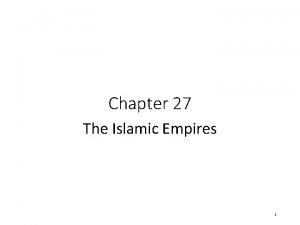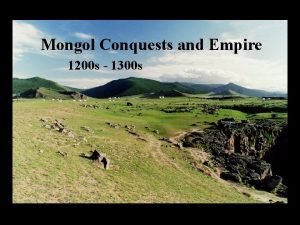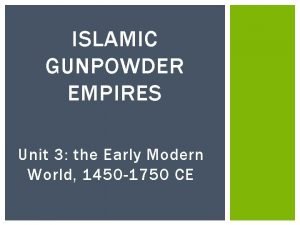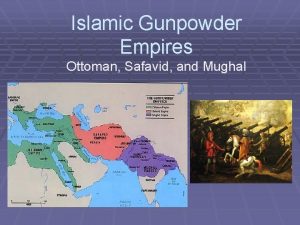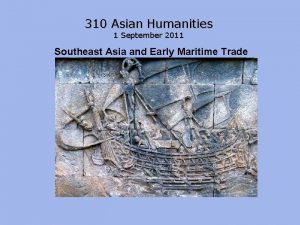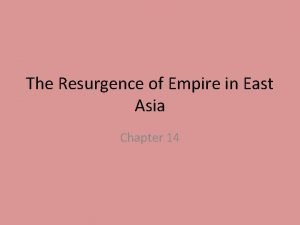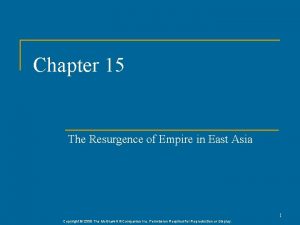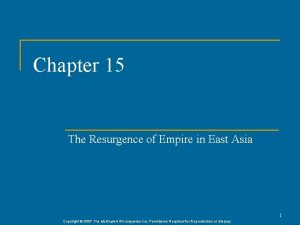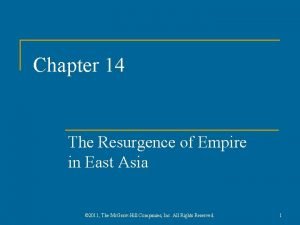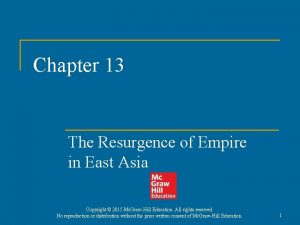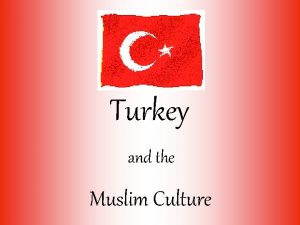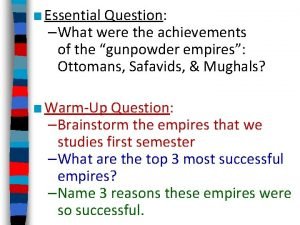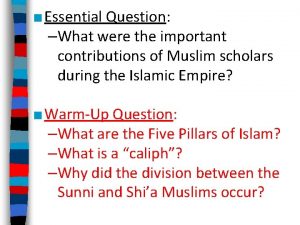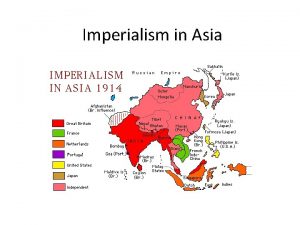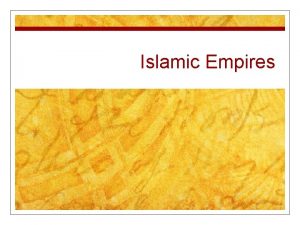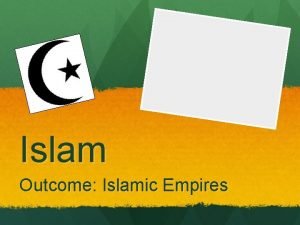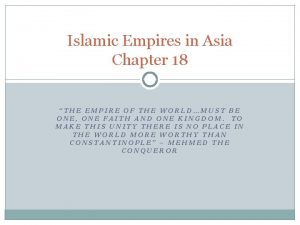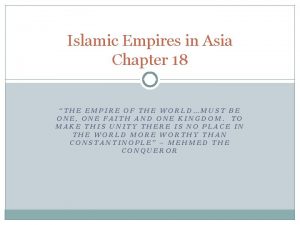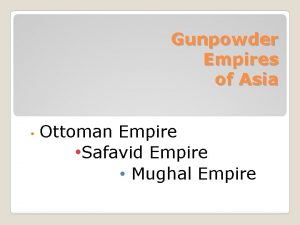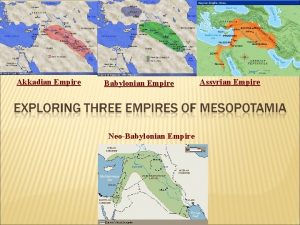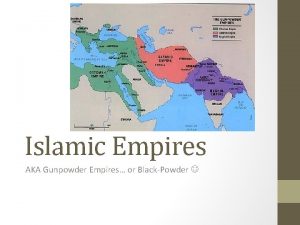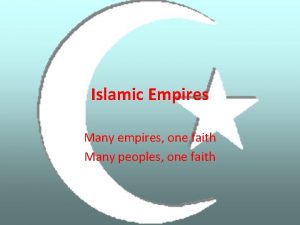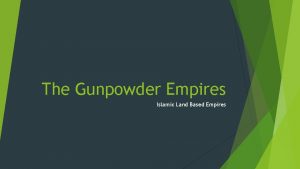Islamic Empires in Asia Chapter 18 THE EMPIRE



















- Slides: 19

Islamic Empires in Asia Chapter 18 “THE EMPIRE OF THE WORLD…MUST BE ONE, ONE FAITH AND ONE KINGDOM. TO MAKE THIS UNITY THERE IS NO PLACE IN THE WORLD MORE WORTHY THAN CONSTANTINOPLE” – MEHMED THE CONQUEROR

Ottoman Empire

Rise of the Ottomans � Ghazis – Warriors for Islam – 1 st Ottomans (Turkish) Anatolia (Asia Minor – Turkey) – Mongolian Persecution Osman – 1200’s ghazi leader – tribe Ottomans � Ottoman Tribe – 1300 s Tried taking Constantinople – failed 1361 took Adrianopolis – 2 nd most important Byzantine city Renamed Edirne – 1369 1 st Ottoman Sultan � Army Elite – Janissaries War captives & Christian Slaves Converted to Islam Belonged to Sultan

Timur – Sword of Islam �Turko-Mongol Leader Born 1336 in Uzbekistan – descendant of Genghis Khan Restoration of Mongol Empire Military genius & tactician 1402 invaded Anatolia – won Battle of Ankara – captured Sultan Ottomans had to return territory taken from ghazi rulers "Till the advent of Hitler, Timur stood forth in history as the supreme example of soulless and unproductive militarism“ – John Saunders

Recovery & Expansion � Civil War – Who’s Next? ? ? 1421 - 1451 Murad II (18 yrs old) – next period of expansion 25 yr war against European Crusaders � Balkans - Anatolia � Battle of Varna - Ended Mehmed II 21 yrs old (post Murad) 1444 -46 & 1451 - 1481 Took Constantinople in 1453 – renamed Istanbul (Capital) Devoted to strengthening navy Took Constantinople with 320 ships & 80 – 200 k troops

The Greatest Sultan �Suleyman – 1520 – 1566 West (Europe) – “The Magnificent” East (Own) – The Lawgiver � Reconstructed legal system Apex of Ottoman military, economic, political power Captured most of Hungary Vienna 1529 – Ended Westward expansion

Ottoman Society �Government Sultan – supreme ruler Grand Viziers – 2 nd in command �Societal Groups Osmanli – ruling class Reaya – “protected flock” “Each man in Turkey carries in his own hand his ancestry and his position in life, which he may make or mar as he will” – Ogier Ghiselin de Busbecq (Roman Emperor’s Ambassador)

Millet System �Millets – Confessional Communities Separate legal courts for communities to rule under “personal law” � Protected religious minority groups Own laws & customs – collected taxes Muslims: ethnicity did not matter (Sunni) Orthodox Christians: included all orthodox sects Armenians: Apostolic, Catholic & Evangelical groups Syriac Orthodox – Oriental Orthodox – asked to be separated from Orthodox Christians Jews

Decline of an Empire �Death of Suleyman 1566 – beginning of the end Rise of European states – France, Spain & Poland 1571 Philip II(Spain) – Battle of Lepanto – European Navy win 1683 John III Sobieski(Poland) – Battle of Vienna – End of Empire � Holy League: Holy Roman Empire & Polish-Lithuanian Commonwealth �Decline in 1600’s – 1700’s End of Silk Road Internal power struggles led to corruption Janissaries rebelled 1700’s: Crimean Peninsula (Black Sea Lands)to the Russians 1798: France takes Egypt Restructuring failed by Sultans 1923 – Turkey established as a Republic – End of the Empire

End of the Silk Road

Safavid Empire

Safavid Empire � Current Day Iran � Safavids descendants of Safiodin (head of family) Muslims – Started Sunni -> 1399 became Shi’ah Kizilbash – Army – “Red Heads” � Esma’il: 1500 -1524 Leader of Safavids 13 yrs old – Avenge his father’s death, new territories, spread Shi’ah Iran and most of Iraq under his control 1501 Tabriz – made capital Shah – “King of Kings” Forced Persians to convert to Shi’ah • • Persia’s neighbors threatened by Shi’ah Ottomans and Uzbek’s invade Persia Tahmasp tried to carry on the fight 1570’s significant territory lost

Shah Abbas the Great � Safavid Unrest (1576 -87) Kizilbash no longer loyal to the Shah � Shah Abbas “the Great” Reformed military using Ottoman model 1598: regained northeastern Persia from Uzbeks � Height of an Empire 1599 moved capital to Esfahan – Iranian Plateau Created a flourishing city Improved manufacturing and foreign trade � carpet weaving, ceramics Empire began a decline after Abbas’ death – ended 1736

Mughal Empire in India

Origins � 1300 s Timur and Turkish Muslims controlled India Who: What: When : Wher e: Why: How: Delhi Capital – 1500 s Rajputs challenged authority Babur “the Tiger” – descendant of Timur Rajputs Indian warrior princes Weakened power of sultans 1500 s Babur Mongol leader (Timur) Attacked Sultanate of Delhi 1526 Delhi Panipat Gain Power Challenged Delhi Sultans Build an Empire Defeated Sultan in Battle

Akbar – Greatest of the Mughal �Reign 1556 – 1605 (13 yrs old) Gained support by including the Rajputs in gov’t Improved tax system – based on a villages avg production over 10 yrs � Harvest bad = no tax – Harvest good = keep excess after tax Supported the arts �Religious Policy Tolerant of all religions Repealed non-Muslim tax Considered himself a Divine ruler – developed a creed claiming “Akbar is God” – Allah Akbar

Height of the Empire �Shah Jahan – 1628 -1658 (Apex) Controlled North & Southern India Vigorous ruler – put down rebellions – Delhi new capital Best known for Taj Mahal (Agra) & Hall of Private Audience (Red Fort @ Delhi) Taj Mahal – tomb for Jahan’s wife Hall of Private Audience – Jahan’s palace B/c of economic burden for construction & maintaining the army taxes were raised �½ of crops raised by individuals �New Religion Sikh – Nanak – tried to unite Muslim & Hindu One God, no idols, less rigid social system 1600’s became militant – enemies of Mughal & Muslims

Taj Mahal & Hall of Private Audience

Aurangzeb � 1657 – Aurangzeb takes power Jahan becomes ill – Aurangzeb kills older brother, imprisons Jahan – becomes emperor Devout Sunni – ended gov’t spending on buildings & monuments Persecuted all non Sunni Restored tax on Hindu’s – destroyed Temples Est the largest territory for Mughals – rioting weakened empire
 Chapter 19 islamic gunpowder empires
Chapter 19 islamic gunpowder empires Chapter 27 the islamic empires
Chapter 27 the islamic empires Chapter 27 the islamic empires
Chapter 27 the islamic empires Land empires
Land empires Islamic gunpowder empires webquest
Islamic gunpowder empires webquest How big was the islamic empire
How big was the islamic empire Impaler state of decay 2
Impaler state of decay 2 Southeast asian alphabets
Southeast asian alphabets Chapter 14 the resurgence of empire in east asia
Chapter 14 the resurgence of empire in east asia Chapter 15 the resurgence of empire in east asia
Chapter 15 the resurgence of empire in east asia Chapter 15 the resurgence of empire in east asia
Chapter 15 the resurgence of empire in east asia Chapter 14 the resurgence of empire in east asia
Chapter 14 the resurgence of empire in east asia The resurgence of empire in east asia chapter 13
The resurgence of empire in east asia chapter 13 Is turkey in europe or asia
Is turkey in europe or asia Akbar's achievements
Akbar's achievements Islamic empire map activity answer key
Islamic empire map activity answer key British empire in asia
British empire in asia Empire asia events marketing sdn bhd
Empire asia events marketing sdn bhd American empire vs british empire
American empire vs british empire Life in the roman empire
Life in the roman empire


